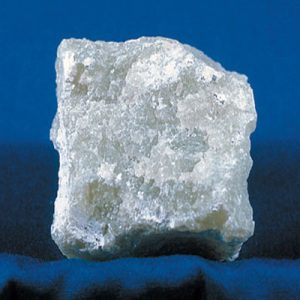Talc
Talc is rarely thought of as a gem type mineral. However, it is an important industrial mineral that is has been used as a surface for lab counter tops and electrical switchboards due to its resistance to heat, electricity and acids. It is also an important filler material in paints, rubber and insecticides and in cosmetics as a lubricating dusting powder. Most people only know Talc as the primary ingredient in talcum powder. Mineral specimens are not very common since it does not usually form very large or attractive crystals. Faceted gems are very rare and difficult to cut due to the perfect cleavage and Mohs hardness of only 1.0 but can be attractive with their pale green translucence. Talc is a Mohs hardness reference mineral.
Distribution of Talc is of widespread occurrence. Some localities for good crystals or pure material include: on Mt. Greiner, Zillertal, Tirol, Austria. At Zermatt, Valais, and St. Gotthard, Ticino, Switzerland. From the Pfitschtal, Trentino-Alto Adige, Italy. At the Trimouns talc deposit, six km northeast of Luzenac, Ariμege, France. From Goepfersgruen, Bavaria, Germany. At Snarum, Norway. In the Onotosk deposit, Irkutsk, Siberia, Russia. In the USA, near Fowler, St. Lawrence County, New York; Delta, York County, Pennsylvania; Smithfield, Providence County, Rhode Island; Rochester, Windsor County, Vermont; Holly Springs, Cherokee County, Georgia; near San Andreas, Calaveras County, California.
| Chemical Formula: | Mg3Si4O10(OH)2 |
| Magnesium Silicate Hydroxide | |
| Molecular Weight: | 379.27 gm |
| Composition: | Magnesium | 19.23 % | Mg | 31.88 % | MgO |
| Silicon | 29.62 % | Si | 63.37 % | SiO2 | |
| Hydrogen | 0.53 % | H | 4.75 % | H2O | |
| Oxygen | 50.62 % | O | |||
| 100.00 % | 100.00 % | = TOTAL OXIDE |
| Crystallography: | Monoclinic – Prismatic |
| Crystal Habit: | Crystals platy, pseudotrigonal pyramids, to 1 cm; fibrous, fine-grained compact, massive |
| Twinning: | None |
| Cleavage: | Perfect on [001] |
| Fracture: | Sub-Conchoidal |
| Tenacity: | Sectile; flexible but not elastic |
| Moh’s Hardness: | 1.0 (Mohs hardness reference species) |
| Density: | 2.58 – 2.83 (g/cm3) |
| Luminescence: | Fluorescent; orange yellow under SW UV, yellow under LW UV (not always fluorescent) |
| Radioactivity: | Not Radioactive Thermal Behaviour: Stable to about 900 degrees Celsius. |
| Other: | Thermal Behaviour: Stable to about 900 degrees Celsius. |
| Color: | Light to dark Green, Brown, White; Colorless in thin section |
| Transparency: | Translucent |
| Luster: | Pearly, Greasy, Dull |
| Refractive Index: | 1.538 – 1.600 Biaxial ( – ) |
| Birefringence: | 0.0510 |
| Dispersion: | Perceptible; r > v |
| Pleochroism: | Weak; only visible in dark varieties |


